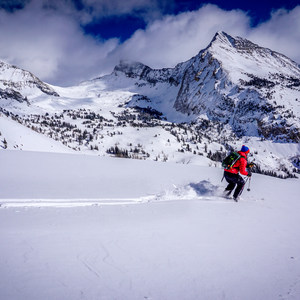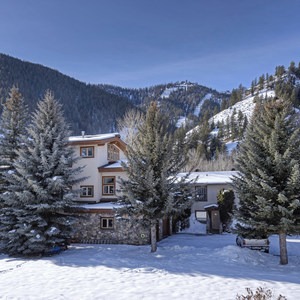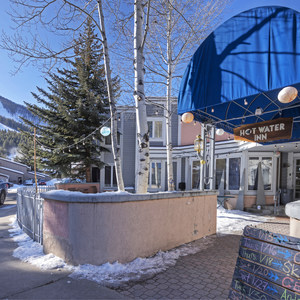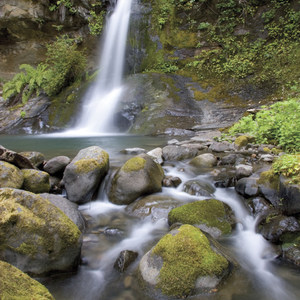Fall Creek Canyon Overview
Fall Creek Canyon is a tributary of the Wildhorse Creek Canyon complex that drains the north side of the 12,000-foot Pioneer Mountain Crest. Though Wildhorse itself is longer and bigger than Fall Creek, a four-wheel drive road climbs nearly to the head of that canyon. The Fall Creek headwaters, by contrast, can only be reached via a 7-mile trail, making it feel much more remote than the Wildhorse Cirque.
The entire Wildhorse complex has experienced extensive mountain glaciation. The rivers of ice draining Wildhorse and Fall Creek merged together and extended down canyon to the mouth of the East Fork of the Big Lost River. At times the Wildhorse Glacier dammed the East Fork, forming a massive glacial lake that backed all the way up to the Copper Basin glaciers.
The Fall Creek Canyon itself drains a series of stunning ridgelines above 11,000 feet. The huge U-shaped canyon captures several additional tributaries that climb into alpine meadows and cirques with beautiful sapphire Lakes.
Surprise Valley
The Surprise Valley Trail begins 3.2 miles up the Fall Creek Canyon Trail. From the junction, the trail climbs through 600 feet of steep switchbacks. The pitch eases a bit, but the hard climb isn’t over until you reach an open meadow at 8,800 feet. Views of the serrated granite face of Pegasus Peak (11,736) greet hikers as they continue a gentle walk through several more scenic openings to the barely discernable pass just under 9,400 feet.
The first small lake in Surprise Valley is nothing to write home about as far as alpine lakes go, but the high peaks festooned with sharp granite fins provide an awesome backdrop. One of the “surprises” is that fact that the main drainage actually flows west through a breach in the wall of the canyon. The rounded granite ridge west of the lake and above the outlet creek offers a beautiful panoramic view into the upper Fall Creek drainage.
Beyond the lake, look for a sign indicating “Surprise Valley - Betty Lake 2 Mi.” The trail is quickly lost in the boggy terrain draining the lake, but it can be found on the other side. Follow it up a steep, open slope marked with cairns to a beautiful creek that tumbles over reddish granite boulders with stunning alpine peaks in the backdrop. After crossing the creek the trail fades into the expansive meadows that can be carpeted with wildflowers well into August.
Near 10,000 feet the trail becomes difficult to find. If you hike cross-country along the west side of the canyon to Lake 10,148, however, you will intersect a well-constructed trail through the talus at around 10,500 feet. This trail leads through several switchbacks to the divide above Broad Canyon and Betty Lake. Though off-trail travel is easy in the lightly forested upper canyon, staying on the east side offers the best chance of staying on the faint trail.
Additional Adventures
The Surprise Valley Trail connects over the divide to Broad Canyon. For hikers willing to run a shuttle, the one-way traverse from Surprise Valley and down Broad Canyon visits several lakes through stunning mountainous terrain. The Fall Creek Canyon Trail also continues a few miles beyond the junction with Surprise Valley. Moose Lake is another spur of the Fall Canyon Trail that splits off just before the Surprise Valley junction.
Off-Trail Hiking
Aside from the potential off-trail hiking that comes from the faded trail in the upper canyon, there are two scrambles to the summit of Standhope Peak. Both the north and northeast ridges look to present Class 3 lines to the summit with some potential for Class 4 routes. Alternatively, the west ridge of Altair Peak (11,825 feet) can be climbed by a Class 3 route from the Surprise/Broad Canyon divide.
Technical Climbing
The abundance of granite fins and faces that drop into Surprise Valley from the north ridge of Pegasus Peak (11,736) are bound to have some technical climbing. Though the rock features and crack systems do not present definitive lines, there is decent potential for moderate routes that meander up the face.
Reference: All content excerpted from Exploring Sun Valley - A Comprehensive Guide to the Boulder, Pioneer, and Smoky Mountains by Idaho River Publications.
Logistics + Planning
Preferable season(s)
Congestion
Parking Pass
Pros
Cons
Trailhead Elevation
Features
Suitable for
Location
Nearby Adventures
Nearby Lodging + Camping
Our mission is to inspire adventure with beautiful, comprehensive and waterproof map-based guidebooks. Owner, publisher, and photographer Matt Leidecker, grew up exploring and guiding on the rivers in central Idaho. His award winning Middle Fork of the Salmon River – A Comprehensive Guide is the standard by which other river guidebooks are measured. Printed on virtually indestructible YUPO paper, IRP guides are truly unique all-in-one resources for adventure. Each book is loaded with full-color maps, stunning photographs, and information on the history, geology, and wildflowers. Visit Idaho River Publications to explore our guidebooks to the Rogue River in Oregon and the mountains of Central Idaho.











Comments
Sign In and share them.